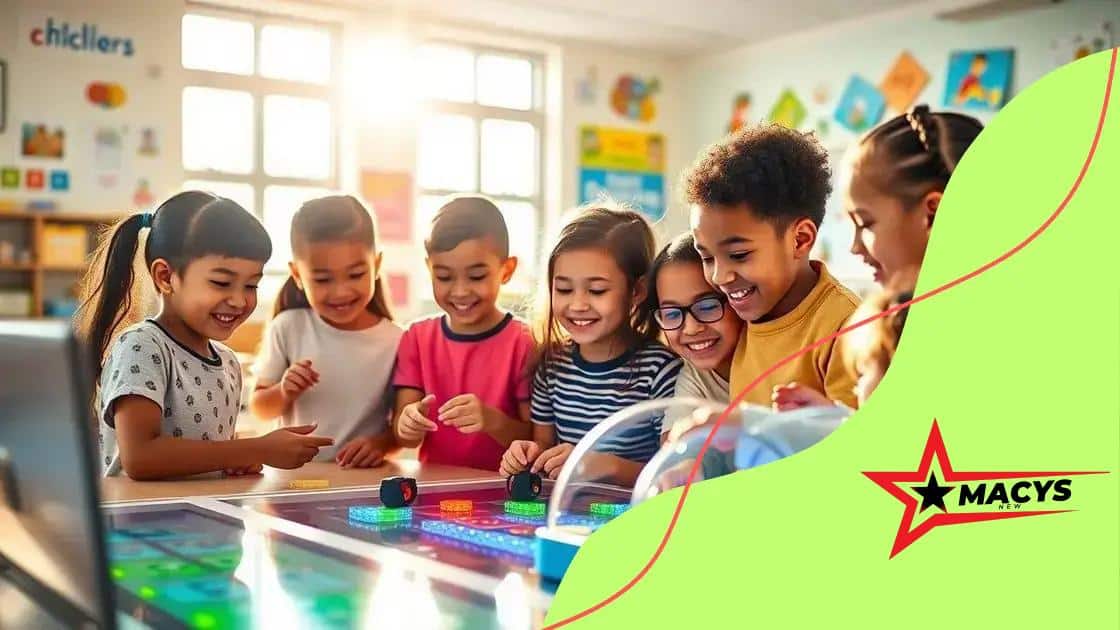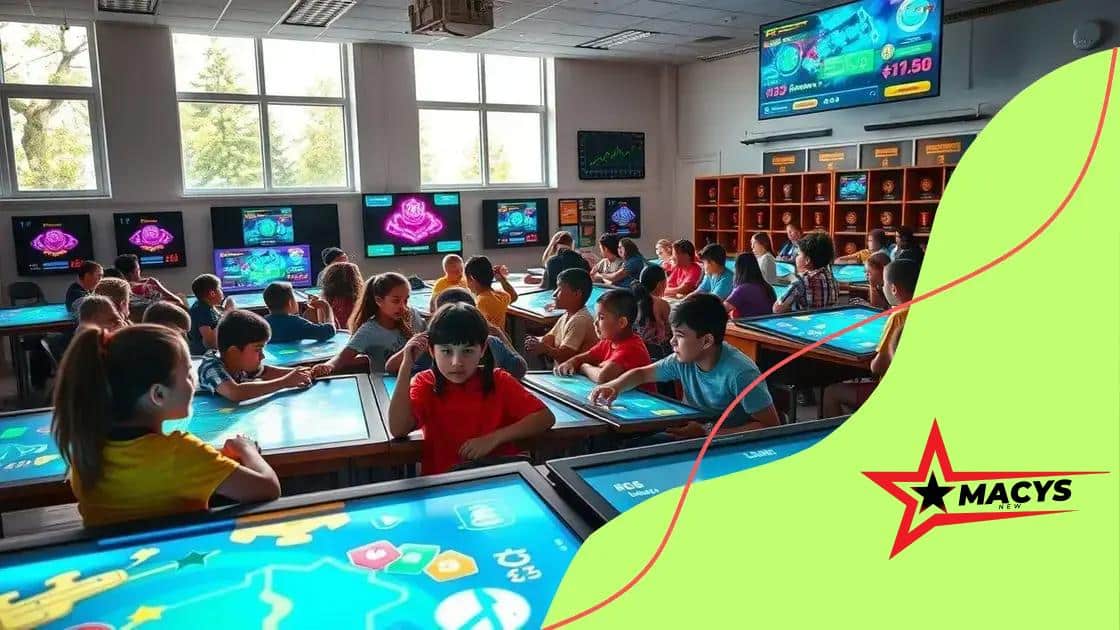Gamification in K-12 education: transforming learning engagement

Gamification in K-12 education enhances student engagement and learning by integrating game elements, fostering motivation, and creating interactive experiences that make learning enjoyable and effective.
Gamification in K-12 education has emerged as a powerful tool to engage students in their learning journey. Have you noticed how games captivate attention? Let’s dive into how this approach can transform education.
Understanding gamification in education
Understanding gamification in education is essential for creating an engaging learning environment. This approach uses game-like elements to motivate students and improve their learning experiences.
What is Gamification?
Gamification integrates game mechanics into non-game contexts. In the classroom, it transforms typical lessons into interactive experiences. Instead of traditional lectures, students participate in activities that mirror video games.
Why Use Gamification?
Gamification offers several benefits that can enhance students’ motivation and engagement. Here are some key reasons:
- Increased engagement: When lessons resemble games, students are naturally more interested.
- Immediate feedback: Digital games often provide instant feedback, allowing learners to understand their performance quickly.
- Goal achievement: Setting challenges and rewards keeps students motivated to reach their learning goals.
Moreover, gamification encourages collaboration among students. With tasks designed for teamwork, learners develop social skills while achieving educational objectives. This collaborative environment fosters a sense of community, making learning enjoyable.
Instructors also benefit from gamification. By incorporating game elements, teachers can create dynamic lesson plans that appeal to various learning styles. These techniques help educators cater to diverse classrooms and keep all students engaged.
As we explore the possibilities of gamification, it is vital to consider the integration of technology. Many tools and platforms are available, allowing teachers to implement gamified elements easily. Using technology effectively can enhance critical thinking, creativity, and problem-solving skills among students.
Understanding gamification is the first step toward creating transformative educational experiences. Embracing this innovative approach can reshape the way students learn and interact in the classroom.
The benefits of gamification for students
The benefits of gamification for students are substantial and can transform their learning experiences. Through engaging techniques, gamification encourages active participation and motivation.
Enhancement of Learning Outcomes
Gamification supports better retention of knowledge. When students learn through play, information becomes easier to remember. Interactive activities capture their attention and reinforce concepts, making the learning process fun.
Boosting Motivation
One of the primary advantages of gamification is its ability to motivate students. By incorporating challenges and rewards, educators create an environment where students strive to complete tasks. This drive to achieve can lead to improved attitudes toward learning.
- Personalized learning: Gamification adapts to individual students’ needs, encouraging them to progress at their own pace.
- Encouragement of risk-taking: Students feel safe to take risks in a gamified environment, knowing that mistakes are part of the learning journey.
- Collaboration: Many gamified activities promote teamwork, helping students develop social skills while working towards common goals.
Furthermore, gamification helps in developing critical thinking and problem-solving skills. As students navigate challenges, they learn to think creatively and strategically. This skill set is essential not only for academic success but also for real-world applications.
Additionally, the competitive aspect of gamification can drive students to improve continuously. They may find themselves more engaged and eager to learn when participating in friendly competitions or achieving rewards.
Incorporating gamification into education also fosters a sense of achievement. The completion of quests and the earning of badges give students tangible proof of their progress, boosting their confidence and commitment to learning.
Best practices for implementing gamification

Best practices for implementing gamification in education can significantly enhance the learning experience for students. By following effective strategies, educators can create engaging and motivating environments.
Starting with Learning Objectives
When introducing gamification, it is crucial to begin with clear learning objectives. Identifying what students should achieve helps in designing activities that align with educational goals. This clarity serves as a foundation for creating meaningful game-like scenarios.
Incorporating Game Mechanics
Incorporating various game mechanics can increase engagement. Some popular mechanics include:
- Points: Reward students with points for completing tasks or participating in activities.
- Levels: Create levels that students can progress through as they master concepts.
- Badges: Use badges to reward achievements and motivate students to reach specific milestones.
These elements stimulate competition and achievement, encouraging students to remain focused and dedicated to their learning.
Another important aspect of gamification is ensuring that it is inclusive. Activities should cater to diverse learning styles and abilities. This approach allows all students to participate and benefit from gamified lessons.
Utilizing technology effectively is also a key practice. Many educational platforms offer tools specifically designed to incorporate gamification. By leveraging these resources, teachers can streamline the implementation process and maximize engagement.
Feedback is essential in any learning process, especially in gamification. Provide timely and constructive feedback to reinforce learning. Positive reinforcement can boost students’ confidence and encourage them to continue striving for success.
Additionally, maintain a balance between competition and collaboration. While competition drives motivation, cooperation fosters social skills. Structuring activities that encourage teamwork can create a supportive classroom environment.
Examples of gamification in K-12 classrooms
Examples of gamification in K-12 classrooms show how effective and engaging learning can be. Many educators are successfully incorporating game elements into their lessons to motivate and involve students.
Interactive Quizzes
Using platforms like Kahoot! or Quizizz, teachers can create interactive quizzes that feel like games. Students compete to answer questions correctly and quickly. This method not only makes learning fun but also enhances student participation.
Classroom Economy
Another effective example is establishing a classroom economy. Students earn classroom currency for good behavior, completing assignments, or helping peers. They can use this currency to buy privileges, like homework passes or extra recess time. This system teaches responsibility and basic economics while making learning more engaging.
- Role-playing games: Teachers can design role-playing scenarios where students take on different characters. This strategy promotes deep learning of historical or literary contexts.
- Project-based learning: Projects can be gamified by allowing students to choose their challenges and earn points or badges as they progress.
- Leaderboards: Displaying leaderboards in the classroom can foster healthy competition. Students can see their progress and strive to improve.
Many classrooms also use storytelling as a gamification tool. By framing lessons as adventures, educators capture students’ imaginations. Students may embark on a quest to solve problems or complete challenges tied to the curriculum. This narrative approach makes the content more relatable and memorable.
Another innovative approach is educational escape rooms. Teachers create puzzles and challenges that students must solve within a set time. This method encourages teamwork and critical thinking while providing a fun, immersive learning environment.
Real-world applications of gamified learning extend beyond academics. Skills such as teamwork, communication, and time management are cultivated naturally through these interactive activities.
Measuring the success of gamification strategies
Measuring the success of gamification strategies is crucial for understanding their effectiveness in the classroom. Educators need reliable methods to assess how well these strategies engage students and enhance learning outcomes.
Setting Clear Metrics
To evaluate the impact of gamification, it is essential to establish clear metrics. These metrics can include:
- Student engagement: Track attendance, participation rates, and interactions during lessons.
- Academic performance: Measure grades, test scores, and completion rates for assignments before and after implementing gamified elements.
- Behavioral changes: Observe any improvements in classroom behavior, teamwork, and cooperation among students.
These metrics provide a framework to analyze how effectively gamified strategies are functioning.
Surveys and Feedback
Collecting feedback from students is another vital aspect of measuring success. Use surveys to gather information on their experiences with gamification. Questions can focus on their motivation, enjoyment, and perceived value of gamified activities. Their insights help educators refine strategies and understand student needs better.
In addition to surveys, focus groups can provide deeper insights. Engaging students in discussions about their learning experiences allows teachers to gather qualitative data that can inform future practices.
Another important factor is evaluating the consistency and quality of the gamified elements. Assess whether the game mechanics remain engaging over time and if they align well with curricular objectives. Regular reviews can help identify areas for improvement and adjustment.
Analyzing group dynamics is crucial too. If certain students excel while others struggle, it may indicate a need to adapt challenges to suit diverse learning styles. Evaluating collaborative activities can also shed light on how well gamification fosters teamwork and communication among peers.
gamification in K-12 education offers exciting opportunities to enhance student engagement and learning outcomes. By implementing interactive strategies, teachers can create a dynamic classroom environment. Understanding how to measure success and adapt methods ensures that all students benefit. As gamification evolves, so does the potential to make learning more enjoyable and effective for everyone.
FAQ – Frequently Asked Questions about Gamification in K-12 Education
What is gamification in education?
Gamification in education is the use of game elements and mechanics to enhance student engagement and motivation in the learning process.
How can gamification improve student learning outcomes?
Gamification can create more interactive and enjoyable learning experiences, helping students retain information better and stay motivated to learn.
What tools can be used for gamifying lessons?
Tools like Kahoot!, Quizizz, and educational escape room kits can help educators implement gamification effectively in their classrooms.
How do I measure the success of gamification strategies?
Success can be measured by tracking student engagement, performance metrics, feedback, and observing behavioral changes in the classroom.





